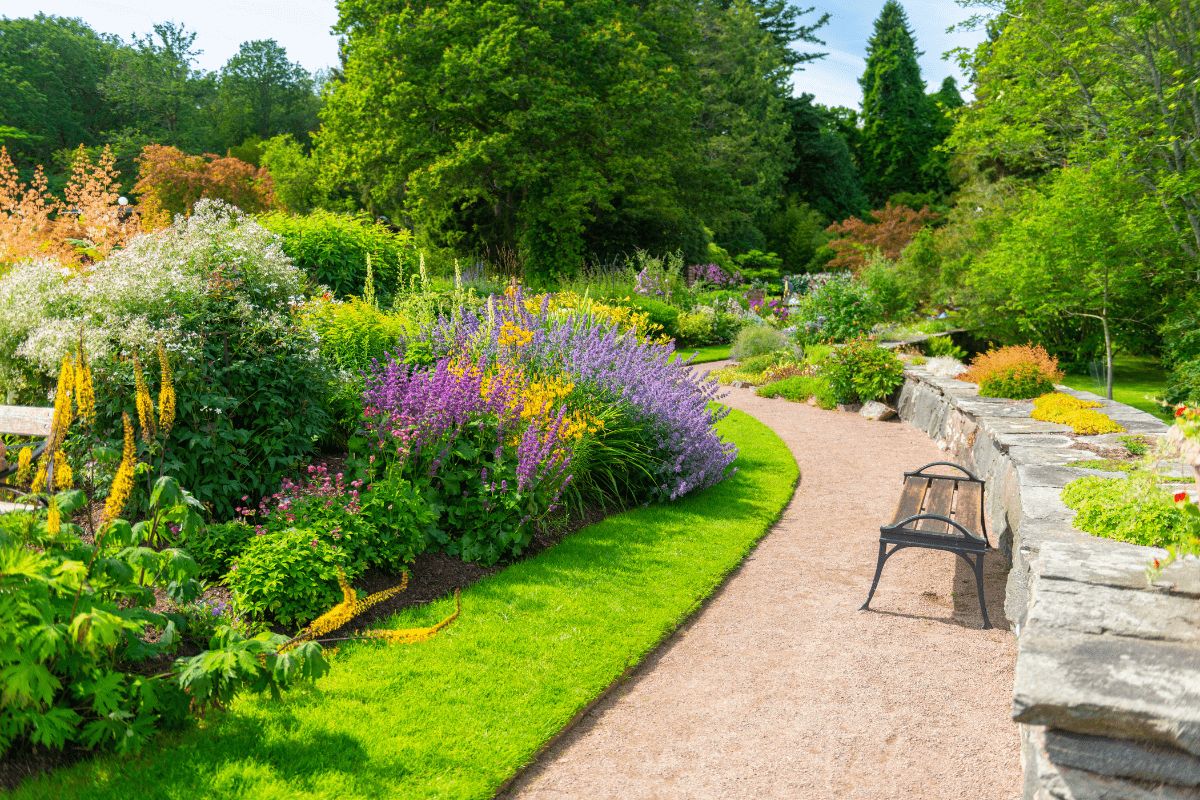Michigan's botanical landscape extends far beyond its famous Great Lakes, encompassing over 3,500 acres of cultivated gardens that somehow manage to thrive despite our "interesting" weather patterns. These living museums collectively welcome nearly 2 million visitors annually, proving that Michiganders will brave any forecast for a good flower photo. From Belle Isle's newly renovated conservatory to the Instagram-famous canopy walks popping up across the state, these gardens offer everything from rare orchid collections to concerts among the chrysanthemums.
Major destinations worth the gas money
Let's start with the heavy hitters… the gardens that make even your plant-killing neighbor consider buying a succulent.
Frederik Meijer Gardens brings sculpture to the succulents
Frederik Meijer Gardens in Grand Rapids isn't just Michigan's most popular botanical destination; it's basically the Disneyland of plants and sculptures, minus the mouse ears. The 158-acre campus welcomed a record-breaking 785,250 visitors in 2024 and celebrated its 16 millionth visitor this past July. USA Today readers have named it the Best Sculpture Park in the United States for three years running, which is particularly impressive considering most of us can't keep a houseplant alive for three weeks.
The practical details matter when you're planning a visit with kids who think "botanical" is a type of Pokemon:
- Open Monday through Saturday, 9am to 5pm
- Sundays from 11am to 5pm
- Tuesday evenings until 9pm (perfect for dates)
- Adults pay $22 admission
- Children 3-13 cost $11
- Military families save $3 per ticket
- EBT/WIC cardholders pay just $2 each
The gardens house Michigan's largest tropical conservatory at 15,000 square feet spanning five stories, because apparently regular-sized conservatories are for quitters. The 8-acre Japanese garden features authentic waterfalls and a teahouse, while over 200 sculptures by artists like Rodin and Ai Weiwei dot the landscape. The annual Butterflies Are Blooming exhibition (March through April) releases 7,000 tropical butterflies from over 60 species, making it the nation's largest temporary butterfly exhibition. Summer brings world-class musicians to the 1,900-seat amphitheater, and winter transforms the grounds with nearly 400,000 lights.
University of Michigan proves free admission still exists
The Matthaei Botanical Gardens and Nichols Arboretum managed by the University of Michigan attracts 525,000 visitors annually across 841 acres at four sites. That's more people than attend UM football games, though admittedly with less tailgating. The best part? Admission is completely free, though metered parking will still get you because this is Ann Arbor and nothing is truly free.
The conservatory opens Tuesday through Sunday (closed Mondays for plant maintenance and staff sanity), while outdoor gardens welcome visitors daily from dawn to dusk. The facility includes 300 acres at Matthaei Botanical Gardens and 123 acres at Nichols Arboretum, featuring a 10,000-square-foot conservatory with three climate zones. The famous Peony Garden at Nichols Arboretum peaks in late May, creating the kind of Instagram backdrop that makes your friends think you've really got your life together.
Beyond pretty flowers, these gardens advance serious conservation work. They're restoring Eastern Massasauga rattlesnake habitat (yes, Michigan has rattlesnakes, surprise!) and protecting Pitcher's thistle, which only grows in Michigan sand dunes. The gardens recently received a $126,091 IMLS grant for natural area surveys and house several plants found in fewer than 10 gardens worldwide, including one with the unpronounceable name Andriamborondrao.
Belle Isle Conservatory emerges from its chrysalis
Anna Scripps Whitcomb Conservatory on Belle Isle reopened in December 2024 after a two-year, $10 million makeover that would make any HGTV host jealous. As the oldest continually operating conservatory in the United States (since 1904), this Albert Kahn-designed building features an 85-foot glass dome that underwent serious renovations. Workers replaced 1,500 glass panes, updated steel trusses, and installed climate control systems that actually work… a minor miracle for any century-old building in Detroit.
The conservatory opens Wednesday through Sunday from 10am to 5pm with free admission, though you'll need a Michigan Recreation Passport to access Belle Isle itself. The facility houses the country's largest municipally owned orchid collection with 600 specimens, proving that Detroit does everything big, including flower collections. Five distinct sections create different climate experiences:
- Palm House under the main dome (steady 70°F)
- Tropical House for humidity lovers
- Cactus House for desert dreams
- Sunken Fernery for Jurassic Park vibes
- Show House for seasonal displays
Hidden gems that locals gatekeep
Some of Michigan's best botanical experiences hide in plain sight, usually with names that sound made up but deliver experiences worth the GPS confusion.
Hidden Lake Gardens lives up to its name
Despite being Michigan's largest botanical garden at 755 acres, Hidden Lake Gardens in Tipton flies under the radar like a botanical ninja. Operated by Michigan State University since 1945, the gardens welcome about 45,000 visitors annually and charge just $10 admission, frequently cited as the "best bargain in Michigan" by people who've clearly never been to a Meijer penny horse ride.
Open Tuesday through Sunday from 9am to 5pm, the facility made headlines with its 2023 addition: the Reach for the Sky Canopy Walk. This 374-foot suspension bridge rises 65 feet above ground, offering views that make your fear of heights seem worth it. The gardens maintain one of the Midwest's largest bonsai collections with specimens ranging from 40 to 100 years old, displayed in the McCready Bonsai Courtyard where touching is definitely not encouraged.
Six miles of paved scenic drives make the gardens accessible to visitors who prefer experiencing nature from behind a windshield, while 12 miles of hiking trails satisfy those who actually own hiking boots. The Harper Collection contains over 600 rare and dwarf conifer specimens, and Hosta Hillside showcases 700+ cultivars despite ongoing restoration from deer damage… because deer have opinions about landscaping too.
Dow Gardens adds canopy walks to chemical legacy
Dow Gardens in Midland attracts 225,000 guests annually to its 110 curated acres, featuring the nation's longest canopy walk at 1,400 feet stretching up to 40 feet high. Annual passes cost $30 per person while daily admission runs $15 for adults and $5 for students, making it the rare Michigan attraction that costs less than a movie ticket.
The Whiting Forest component opened to spectacular reviews, increasing attendance by 300% and earning industry awards. The historic Pines House, built in 1899 and designated a National Historic Landmark, offers tours alongside year-round tropical displays in the conservatory. Summer hours extend to 8pm, allowing evening strolls when the heat index drops below "surface of Mercury."
September 2024 saw groundbreaking for a new 22,200-square-foot Welcome Center, because nothing says "welcome" like 22,200 square feet. The entire facility offers barrier-free hard-surfaced pathways with wheelchairs available for reservation, ensuring everyone can enjoy the gardens regardless of mobility needs.
Fernwood preserves ecosystems and sanity
Fernwood Botanical Garden and Nature Preserve near Niles protects 105 acres along the St. Joseph River, encompassing at least 10 distinct ecosystems in case you want to experience multiple biomes without leaving Southwest Michigan. The facility includes 8 acres of landscape gardens, a 50-acre woodland preserve, a 40-acre arboretum, and 5 acres of restored tallgrass prairie established in 1976 when disco was king and prairie restoration was radical.
The conservatory houses over 100 types of tropical ferns, while outdoor collections include a Japanese dry garden (no water, all zen), herb garden, rain garden, and railway garden that proves model trains belong outdoors too. Educational programs serve 4,000 area students annually, with adult programming encompassing over 300 classes in natural sciences, gardening, and art. The winter LIGHTS at Fernwood display runs November through January, because Michigan winters need all the brightness they can get.
Seasonal spectacles throughout the year
Michigan gardens transform with each season, offering different experiences depending on when you visit and how many layers you're wearing.
Spring brings blooms and crowds
Spring erupts across Michigan's gardens with enthusiasm that makes winter seem like a bad dream. Holland's Tulip Time Festival (May 2-11, 2025) at Windmill Island Gardens showcases over 150,000 tulips around De Zwaan, the only authentic operating Dutch windmill in America. Because nothing says "Michigan" like importing Dutch culture wholesale.
Frederik Meijer Gardens' cherry trees typically reach 70% bloom between April 23-28, creating scenes worthy of your most pretentious Instagram caption. The renowned Peony Garden at Nichols Arboretum peaks in late May, when thousands of blooms create the kind of display that makes you consider taking up watercolor painting.
Spring plant sales at university gardens offer rare opportunities to buy unusual plants you'll definitely keep alive this time:
- Matthaei hosts four distinct sales
- Specialty plants unavailable at box stores
- Expert advice from actual experts
- Prices supporting conservation programs
- Early morning lines rivaling Black Friday
Summer means concerts and extended hours
Summer transforms gardens into outdoor concert venues, with Frederik Meijer Gardens' Fifth Third Bank Summer Concerts attracting world-class musicians from June through September. The Michigan 4-H Children's Garden at MSU celebrates its 31st year as the nation's first children's garden on a university campus, with 10,000 children participating in programs that hopefully inspire the next generation of plant enthusiasts.
Multiple gardens extend hours during summer months:
- Dow Gardens stays open until 8pm
- Tuesday evenings at Frederik Meijer until 9pm
- Special member-only morning hours
- Evening photography workshops
- Sunset tours worth setting alarms
Fall foliage beats pumpkin spice
Fall transforms Michigan's botanical spaces into photography destinations that make leaf-peeping seem like a legitimate hobby. Hidden Lake Gardens' annual Run for the Hills 5K coincides with peak foliage, combining exercise with extraordinary views across 755 acres. Frederik Meijer Gardens' Chrysanthemums & More! exhibition (September 15 through October 29) fills greenhouses with thousands of blooms in colors that shouldn't exist in nature but somehow do.
The canopy walks at both Hidden Lake and Dow Gardens offer spectacular autumn vistas from perspectives that make your slight fear of heights worthwhile. Professional photographers stalk these grounds like botanical paparazzi, waiting for perfect light conditions that last approximately 3.7 seconds.
Winter proves tropical plants beat seasonal depression
Winter showcases elaborate holiday displays that convince visitors to brave Michigan weather. Frederik Meijer Gardens' Christmas & Holiday Traditions features nearly 400,000 lights and over 40 international trees from late November through early January. The display attracts crowds that prove Michiganders will stand in line for anything involving hot chocolate.
Belle Isle Conservatory's tropical environments offer year-round refuge, particularly valuable after its recent renovation. Multiple gardens host holiday light displays:
- Dow Gardens offers free community evenings
- Fernwood presents its LIGHTS exhibition
- Special member preview nights
- Hot beverage stations strategically placed
- Instagram opportunities every three feet
Conservation efforts beyond pretty flowers
Michigan's botanical institutions advance critical conservation work that extends far beyond their role as selfie backdrops.
Matthaei Botanical Gardens leads habitat restoration for Eastern Massasauga rattlesnakes while protecting globally rare species with names that sound like Harry Potter spells. The gardens grow plants found in fewer than 10 institutions worldwide and support research across 40+ university courses. Their recent IMLS grant supports comprehensive surveys that help understand what's actually growing in Michigan's natural areas.
Frederik Meijer Gardens maintains the Kenneth E. Nelson Carnivorous Plant House, the only publicly displayed collection in the United States dedicated exclusively to plants that eat things. MSU's W.J. Beal Botanical Garden, the nation's oldest continuously operated university botanical garden (established 1873), maintains research collections of 2,000+ plants with detailed provenance data that would make ancestry.com jealous.
Planning your garden adventure
Practical details make the difference between a perfect garden visit and a day spent mostly looking for parking.
Admission prices vary wildly
Garden admission ranges from free to "maybe I'll just look at pictures online":
- FREE: Matthaei Botanical Gardens, Belle Isle Conservatory
- $10: Hidden Lake Gardens (best value)
- $15: Dow Gardens adult admission
- $22: Frederik Meijer Gardens (most expensive)
- Variable: Special events and programs
Annual memberships typically pay for themselves within 3-4 visits while supporting conservation programs. Most memberships include reciprocal benefits at 380+ gardens nationwide through the American Horticultural Society.
Accessibility features welcome everyone
Major institutions provide excellent accessibility accommodations because gardens should be for everyone:
- Hidden Lake: 6 miles of paved drives
- Dow Gardens: Wheelchair reservations available
- Frederik Meijer: Fully accessible, cashless venue
- Reverse ATMs for cash believers
- Accessible parking near entrances
Photography policies stay reasonable
Personal photography is welcome at all gardens, though professional shoots require permits and fees that vary by how many reflectors you're carrying. Wedding photographers particularly love these venues, leading to permit requirements that prevent every garden path from becoming a bridal runway.
The bottom line on Michigan's gardens
These living museums collectively serve nearly 2 million annual visitors while protecting thousands of plant species and educating tens of thousands of students. Recent investments including Belle Isle's $10 million renovation and record attendance at multiple venues signal growing recognition of gardens' value for mental health, environmental education, and community building.
Whether seeking spring's first blooms, summer concert evenings, fall's spectacular colors, or winter's illuminated wonderlands, Michigan's botanical gardens provide year-round destinations where nature, art, science, and community somehow coexist peacefully. Just remember to check hours before driving an hour to find a "Closed Mondays" sign, bring layers because Michigan weather has commitment issues, and prepare to leave wanting your own Japanese garden that you'll definitely maintain this time. Really.





